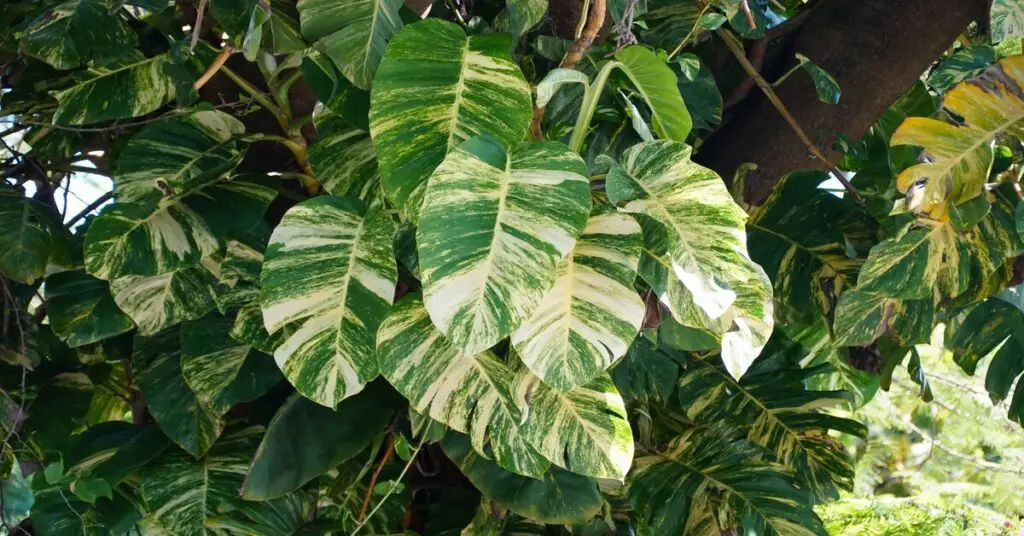Hawaiian pothos, also known as giant Hawaiian pothos, and Epipremnum Aureum Hawaiian. Is a plant that originates from French Polynesia. It is from the Araceae family and the Epipremnum genus.
Giant pothos plants have green and yellow variegated coloring. Heart-shaped leaves and vining stems. They can grow 4′ long or more when grown indoors.
Hawaiian Pothos Care
If you purchase a giant Hawaiian pothos, you will need to inform yourself about its care – thankfully, we can help. The care for this plant is simple.
From watering needs to possible toxicities, you can find all the information about giant pothos care below!
Soil
A well-draining soil with high organic matter is best. Additions of perlite, coco coir, and vermiculite can achieve that. And it’s also important to note that giant pothos like a neutral soil pH of 6.6 to 7.3.
Watering
The watering needs for a giant pothos are moderate. That means that over or undersaturation should be avoided. The best way to know if this plant should receive water is to feel if the top 2″ of soil is dry. You want to ensure the plant is thoroughly hydrated. So, water it until you see it flow through the pot’s drainage holes.
Lighting
Giant Hawaiian pothos can tolerate many lighting options except for full sun. Too much sun exposure can burn the plant’s foliage. We find that the best type of lighting for the plant is partial shade to indirect/filtered sun.
Humidity & Temperature
The proper temperature for this plant is between 65°F and 85°F or 18.3 and 29.4. This plant does not do well in the cold and will fail to thrive at temperatures 50°F or 10°C and below. Hawaiian pothos like a humidity level of 50% to 70%. High humidity levels such as those can be challenging to achieve in drier indoor climates. Misting the plant frequently or placing a humidifier near the plant can help achieve proper levels.
Fertilizing
A well-balanced fertilizer applied once a month throughout spring and summer is optimal for the plant. It thrives when given fertilizer which helps it produce luxuriant foliage.
Propagation
The best form of propagation for giant pothos is stem cuttings. To propagate a stem cutting, you will need to cut one that is 6″ to 8″ in length and has five to six leaves attached. Once cut, remove all but two leaves and place the stem in a several-inch deep glass of water. Once it grows roots in six to eight weeks, you can plant it. Remember to change the water out once a week.
Diseases & Pests
Phytophthora, a harmful oomycete, is the most common disease to affect any pothos plant [1]. Signs of Phytophthora root rot are dark brown and black leaves. Phytophthora nicotianae causes the disease and typically happens from irrigation. But can be avoided when grown as a houseplant.
Giant Hawaiian pothos are susceptible to typical houseplant pests, including scales and mealybugs. Aphids and spider mites can also be an issue but are less common. Insecticidal soap can help mitigate the pests.
Toxicity
This plant contains calcium oxalates. When any part of a Hawaiian pothos is ingested, humans, felines, and canines may experience symptoms of irritation around the mouth or on the skin. Animals may also experience vomiting or excessive drooling. [2]
Hawaiian Pothos vs. Golden Pothos
The difference between Hawaiian pothos and golden pothos is leaf size. Despite their similar coloring and shape, they are not the same. The former has larger leaves (bigger than the average hand), and the latter remains smaller.
References:
[1]Norman, D. J., & All, G. S. (2018, July 30). PP340/pp340: Pothos (epipremnum aureum) diseases: Identification and control in commercial greenhouse production. askifas. Retrieved October 21, 2022, from https://edis.ifas.ufl.edu/publication/PP340
[2]Plants that are toxic to dogs. America’s Vet Dogs. (n.d.). Retrieved October 21, 2022, from https://www.vetdogs.org/AV/E_and_N/Blog_Posts/plants-that-are-toxic-to-dogs.aspx

